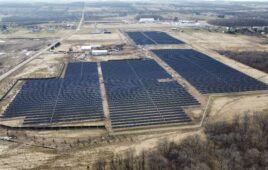By Vince Salvati, Vice President and CFO, Solar SpeedRack
 While much has been written recently about rail-less racking systems as the wave of the future, we can’t find much on shared-rail systems. It is true that rail-less represents a significant improvement over the mid- and end-clamp systems currently on the market, however, it seems that shared rail systems have most (if not all) of the advantages claimed by the rail-less systems without many of their drawbacks. Here is a list of most of the attributes that a rail-less system offers, published earlier this year by Greentech Media:
While much has been written recently about rail-less racking systems as the wave of the future, we can’t find much on shared-rail systems. It is true that rail-less represents a significant improvement over the mid- and end-clamp systems currently on the market, however, it seems that shared rail systems have most (if not all) of the advantages claimed by the rail-less systems without many of their drawbacks. Here is a list of most of the attributes that a rail-less system offers, published earlier this year by Greentech Media:
- Fast and easy for installers
- Simple for the designers
- Landscape and portrait installs
- Compatible with composite and tile roofs
- Robust flashing and roof sealing
- Roof rafter attachment
- Integrated grounding
- Easy height adjustment and array leveling
- High strength and low weight
- Reduced parts count
- Standard tools and hardware
- PV module-agnostic
- Top-notch aesthetics
What are shared rail systems?
Quite simply, the rails themselves are used to hold the modules in place eliminating the need for mid and end clamps. There are less components than in other systems, so there are fewer parts to carry up to the roof, making installation easier on the installer.
Because the rails are shared, a two-up installation would require only three rails as compared to four for a standard mid and end clamp system. Shared-rail systems have been proven to install faster than end and mid clamp systems, and they can be used for either landscape or portrait installations on all types of roofs.
Shared-rail systems require significantly fewer roof penetrations, with all penetrations being on a rafter. As such, there is no risk of a “floating” penetration, which could occur in some rail-less installations.
Some shared-rail systems have integrated grounding. The number of parts in this system are a fraction of those required for a mid and end clamp installation and can be adjusted up and down and side to side during installation by the simple turn of a bolt on the L-foot.
Training an installer on a shared rail system takes significantly less time than required to master either mid and end clamp or rail less systems. The most difficult part is to make sure that the rails are “square,” which can be accomplished simply by use of spacer bars.
Two of the attributes that conflict with each other are high strength and low weight. One of the major drawbacks of both mid and end clamp and rail-less systems is they attach to only a small part of the panel frame, which over time can create damage to the panel due to micro fractures and results in loss of output. Because shared rail systems cover the entire side of the panel, the panel frame becomes “bonded” to the rails making for a much stronger and secure aesthetically pleasing installation.
On the issue of weight, it is true that the shared rail system would weigh more than a rail less system, but it weighs considerably less than a mid and end clamp system due to fewer rails and component parts required. The shared-rail system is particularly well suited for area where snow load is a factor. Again, clamping of the entire side of the module reduces the strain on the panel frame as compared with either mid and end clamp or rail less systems.
So what about considering shared rail systems as part of the next game changer in solar racking? We believe so, as you get most of the advantages that a rail-less system promises without the shortcomings noted above.
In a follow-on article also published in Greentech Media, the author believes that within the next year or two rail-less systems will have a cost advantage over railed systems. While he may be correct on the hardware cost by itself, we believe that he has understated a key disadvantage that rail-less systems will find near impossible to overcome.
Roof penetrations may be the Achilles heel of rail-less systems. Nearly every installer and roofer with whom we deal express concern over the number of roof penetrations required for system installation. Roof penetrations are time consuming and costly, plus, if improperly sealed, can create major post-installation problems and liabilities.
Let’s compare a nine-panel, three-up by three-across project. A rail-less system would require six penetrations per row, plus an additional six to secure the top row for a total of 24. Current shared-rail systems require as few as eight roof penetrations. This difference of 16 roof penetrations cannot be overlooked in terms of the overall impact on installation time and cost.
While we do not disagree that rail-less systems have a place in the residential market, we believe that shared-rail systems enjoy virtually all of the benefits with few of the drawbacks of the current generation of rail-less systems.
So, if you are looking to a future of faster installs with less parts and fewer roof penetrations to manage, why not give a shared rail system a try?





I concur with Marshall Green’s comment regarding mount spacing, and would like to add that many installers standardize on the typical spans that AHJ’s allow in their selling territory. The racking manufacturer’s engineering might allow longer spans, however ease of permitting and consistent procedures for company installers often override these to a sure-bet. Here in NJ, most installers will default to 48″ staggered spans whether it’s a rail-based or rail-less installation. Using this logic, rail-less systems would have the same number of penetrations as the shared rail system but fewer parts, no long rails, etc. thus saving money overall on labor and logistics.
A diagram is needed.
Perhaps this comparison will help.
http://solarspeedrack.com/pdf/ComparisonFlyer.pdf
I think shared rail systems are exciting and have a big place in the future landscape. A few comments on the article above:
Weight is not really the issue with rails. Shipping long members is more expensive and requires additional handling and storage capabilities as well as installation time.
Rail free systems that attach to the sheathing do have more mounts as well as a questionable lifespan on the screwed attachment to variable density materials like plywood and OSB, however
Rail Free Systems that attach to rafters commonly have similar mount spacings (same number of mounts and penetrations) as rail based systems.